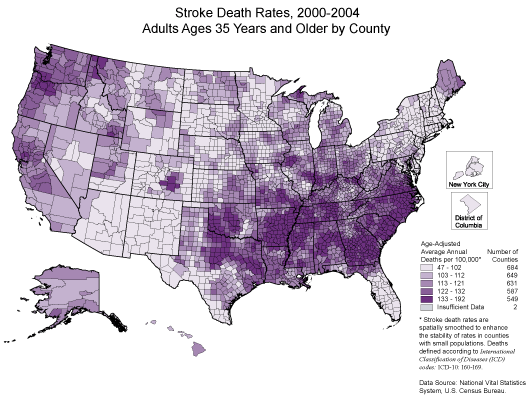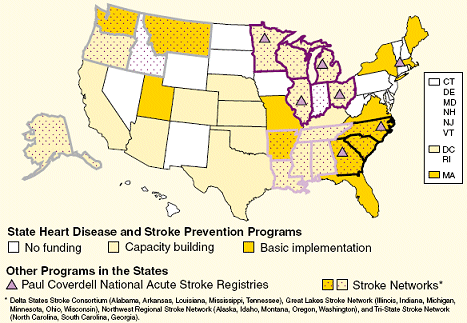 |
|
 |
 |
 |
Fact Sheets and At-a-Glance Reports
Stroke Fact Sheet
This document is also available in
Portable
Document Format (PDF–397K).
Learn more about
PDFs
.

 Click
HERE to view a larger version
of this map. (PDF 133K) Click
HERE to view a larger version
of this map. (PDF 133K)
* Stroke death rates are
spatially smoothed to enhance the stability of rates in counties with small
populations. Deaths defined according to International Classification of
Diseases (ICD) codes: ICD–10: 160–169.
Stroke Facts
- Each year, more than 150,000 people in the United States die from
stroke, making stroke the third leading cause of death.1
- In 2004, the overall stroke death rate per 100,000 people
was 50.0 for the total population, 74.9 for black men, 65.5 for black
women, 48.1 for white men, and 47.2 for white women.1
- In 2004, the states with the highest age-adjusted stroke
death rates per 100,000 were South Carolina (65.2), Alabama (65.0),
Arkansas (65.0), Tennessee (64.7), and North Carolina (61.1).2
- Nearly 780,000 strokes occur in the United States each
year. About 600,000 of these are first strokes, and nearly 180,000 occur
in people who have already had a stroke.1
- Stroke is the leading cause of serious long-term
disability. In 1999, more than 1.1 million stroke survivors reported
difficulty with functional limitations and daily activities.3
- For 2008, the American Heart Association estimated direct
and indirect costs for stroke at $65.5 billion.1
- According to 2005 Behavioral Risk Factor Surveillance
System data, 2.6% of U.S. adults had a history of stroke.4
- Common stroke warning signs include
- Sudden numbness or weakness of the face, arm, or leg—especially on
one side of the body.
- Sudden confusion, trouble speaking or understanding.
- Sudden trouble seeing in one or both eyes.
- Sudden trouble walking, dizziness, loss of balance or coordination.
- Sudden severe headache with no known cause.
- Risk factors for stroke include older age, male gender, black
race/ethnicity, family history of stroke, physical inactivity and
obesity, cigarette smoking, diabetes, high cholesterol, high blood
pressure, atrial fibrillation, peripheral artery disease, or cartoid or
other artery disease.
CDC's Stroke Prevention Program
CDC currently funds health departments in 33 states and the District of
Columbia to develop, implement, and evaluate programs that promote
heart-healthy and stroke-free communities; prevent and control heart
disease, stroke, and their risk factors; and eliminate disparities among
populations,
http://www.cdc.gov/dhdsp/state_program/. For more information on CDC
state programs, including WISEWOMAN (Well-Integrated Screening and
Evaluation for Women Across the Nation) and State Cardiovascular Health
Examination Survey, visit
http://www.cdc.gov/wisewoman/, and
http://www.cdc.gov/dhdsp/examination_survey.htm.

CDC Activities to Reduce the Stroke Burden
CDC's Heart Disease and Stroke Prevention Program
CDC currently funds health departments in 32 states and the District
of Columbia to develop effective strategies to reduce the burden of
heart disease and stroke and related risk factors. This program
emphasizes the need for policy and program changes that promote
heart-healthy and stroke-free living and working conditions.
Paul Coverdell National Acute Stroke Registry
CDC funds four state health departments (Georgia, Illinois, Massachusetts, and North
Carolina) to establish state-based Paul Coverdell National Acute Stroke
Registries with the mission of monitoring, promoting, and improving the
quality of acute stroke care in their states. These were established after
testing and evaluating eight prototype projects. The data collected will
guide quality improvement interventions at the hospital level that will
fill the gap between clinical guidelines and practice. The registries will
help facilitate necessary policy and system changes at national, state, and
local levels that will result in improvement in patient outcomes. The
long-term goal of this program is to ensure that all Americans receive the
highest quality of acute stroke care that is available to reduce untimely
deaths, prevent disability, and avoid recurrent strokes.
Stroke Networks
Stroke networks allow state health departments and their partners to
share and coordinate prevention activities and advocacy strategies. CDC
supports the Tri-State Stroke Network in Georgia, South Carolina, and
North Carolina and the Delta State Stroke Consortium in Alabama,
Mississippi, Louisiana, Arkansas, and Tennessee.
Resources
Atlas of Stroke
Hospitalizations Among Medicare Beneficiaries
County-level maps of stroke hospitalizations by stroke subtype, race and
ethnicity, discharge status, comorbidity, hospital facilities, and stroke
specialists.
Web-based Interactive Maps
of Heart Disease and Stroke
Downloadable county-level maps of stroke and heart disease mortality and
stroke hospitalizations.
Heart-Healthy and Stroke-Free: A
Social Environment Handbook
Strategies for public health professionals and community and state leaders
to assess the conditions for heart-healthy and stroke-free living in
communities.
Taking Action for
Heart-Healthy and Stroke-Free States: A Communication Guide for Policy and
Environmental Change
Information to help public health programs across the country reduce the
disabling and costly national tragedy of heart disease and stroke.
Successful Business Strategies to
Prevent Heart Disease and Stroke Toolkit
Provides examples of programs that have successfully promoted cardiovascular
health and reduced people's risk for heart disease and stroke in work site
and health care settings.
For More Information Online
For more information about stroke warning signs, risk factors, prevention, treatment, and new
research, please visit the following Web sites of the Centers for Disease
Control and Prevention (CDC) and its partners.
References
- American Heart Association. Heart Disease and Stroke
Statistics—2008 Update. Dallas, Texas: American Heart Association,
2008.
- Minino AM, Heron MP, Murphy SL, Kochanek KD. Deaths: Final data for
2004. Natl Vital Stat Rep 2007;55(19):1–120.
- Centers for Disease Control and Prevention. Prevalence of
disabilities and associated health conditions among adults—United
States, 1999. MMWR 2001;50(7):120–125.
- Centers for Disease Control and Prevention. Prevalence of
stroke—United States, 2005. MMWR 2007;56(19):469–474.
Back to top
*Links to non–Federal organizations are provided solely as a service to our users. Links do not constitute an endorsement of any organization by CDC or the Federal Government, and none should be inferred. The CDC is not responsible for the content of the individual organization Web pages found at this link.
Page last reviewed:
June 25, 2008
Page last modified: June 25, 2008
Content source: Division for Heart Disease and Stroke
Prevention,
National Center for Chronic Disease Prevention and
Health Promotion |
 |